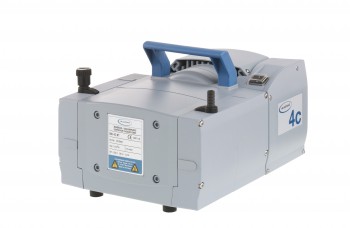How to select the right vacuum pump
When it comes to selecting a vacuum pump there are a number of options for choosing the best pump for your application. Vacuum pumps are available in different types that offer varying displacement capacities and ultimate vacuum levels.
There are four main types commonly used in laboratories for freeze drying (lyophilization), evaporation and concentration.
.jpg) Rotary Vane
Rotary Vane
Traditional Rotary Vane (RV) Vacuum Pumps are often used because they can have a lower up-front cost, are smaller than other types, and can be used with multiple applications. RV pumps use oil to ensure a tight seal, lubricate the working parts and remove heat to cool the rotors.
Any solvents that are not trapped or recovered before they enter the RV vacuum pump can condense in the pump oil and damage the inside of the pump. It’s necessary when using an RV pump to collect the evaporated vapors upstream of the pump. Condensers or Cold Traps are commonly used to collect these vapors and protect the pump.
Another downside of the RV pump is that the oil must be changed which is a costly process. It is recommended that the oil in these pumps be checked regularly and changed approximately every 3,000 hours of use.
The life of the vacuum pump depends on the maintenance of the oil. While there are systems that automate oil changing, time is still lost while the pump is out of use for the maintenance.
Rotary Vane vacuum pumps reach deep ultimate vacuum levels and have high displacement capacity. This makes them a good choice for freeze drying applications. RV pumps work especially well for aqueous samples and solvents with high boiling points whose vapors can be easily trapped before they reach the pump.
 Diaphragm
Diaphragm
Diaphragm Vacuum Pumps are dry pumps that operate using a pulsing motion that opens and closes valves to move air. This design eliminates the need for oil. The valves are often made of polytetrafluoroethylene making the pump resistant to corrosives and less susceptible to damage from vapors.
While they can have a higher up-front cost, they do not use any oil so operation and maintenance costs are significantly lower than pumps that require oil. Diaphragm pumps can handle highly viscous liquids and be used with a wide range of samples but the applications are limited to those requiring higher ultimate vacuum levels.
Ultimate vacuum levels of these pumps are not extremely deep and displacement capacities are much lower than other types of vacuum pumps.
Diaphragm pumps are one of the most chemical- and corrosion-resistant types of pumps. Therefore, almost any type of sample, even those containing a combination of solvents and acids can be used with these pumps, making them a good choice for both evaporation and concentration.
A diaphragm pump can’t be used for freeze drying since the depth of vacuum isn’t enough.
.jpg) Combination (Hybrid)
Combination (Hybrid)
Combination Vacuum Pumps, also known as Hybrid Vacuum Pumps, have both a Rotary Vane and Diaphragm pump together in the same vacuum pump. In a combination pump the diaphragm pump keeps the oil of the RV pump under negative pressure to reduce or eliminate vapors going through it and condensing in the oil. This design keeps the oil cleaner and allows for less frequent changing – oil lasts up to 10 times longer between changes compared to RV pumps.
So while there may be a higher up-front cost than an RV pump, the operation costs are lowered as less replacement oil is needed and less time is lost changing the oil. The ultimate vacuum level and displacement capacity with combination pumps is similar to those of RV pumps. Because the diaphragm pump is incorporated into the design, these pumps are better at handling acids and solvents than RV pumps.
Combination pumps are recommended for freeze drying corrosive or volatile samples as they can be used with acidic samples and those containing harsh chemicals such as TFA, acetonitrile, HBe and Nitric acid.
.jpg) Scroll
Scroll
Scroll Vacuum Pumps are dry pumps that use two spiral scrolls to compress air and vapors and move them toward the exhaust. While they can have higher up-front costs, the lifetime operation costs are much lower because they don’t require oil and very little maintenance is needed.
It is recommended that the scrolls be changed every 40,000 hours of use. By eliminating the oil, the hydrocarbon-free design means these pumps are environmentally friendly as well. Scroll pumps handle water vapor better than most types of pumps and make significantly less noise during operation.
Because the scrolls are made of metal, even on chemical- or corrosion-resistant models, only samples with acids below 20% are recommended. Compared to diaphragm pumps, scroll pumps can reach deeper ultimate vacuum levels and have higher displacement capacities.
Scroll pumps are recommended for freeze drying as they can be used with aqueous and solvent samples including acetonitrile. They may be used with concentration applications also, however the cost tradeoff may make another type of pump more attractive.
In Conclusion
No matter what type of pump you’re using, one of the most important things to remember about vacuum pumps is that whatever goes in the pump will come out! Even with filters, you need to take other precautions when samples include potentially hazardous materials. Venting into a fume hood is required when using hazardous samples.
Labconco offers multiple vacuum pump options and many vacuum pump accessories including the new Scroll Pumps. If you’re unsure which vacuum pump is the best for your application, our Application Specialists are always here to help.
Download the Vacuum Pump Selection Guide
The Vacuum Pump Selection Guide provides helpful information on choosing the right pump for your laboratory product. Types of pumps and their uses are discussed.
| chevron_left | 4 questions to answer when selecting an evaporator | Articles | Axiom Week: Day 5 | chevron_right |





